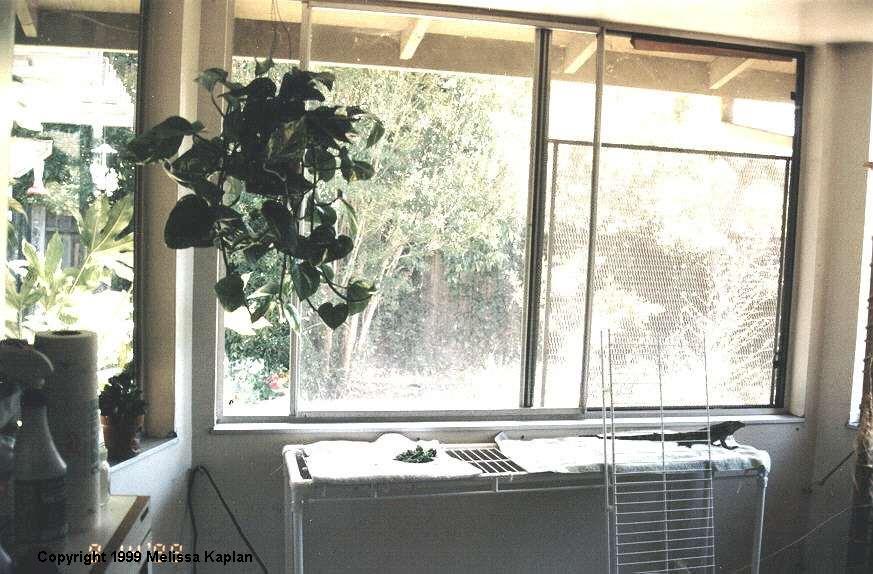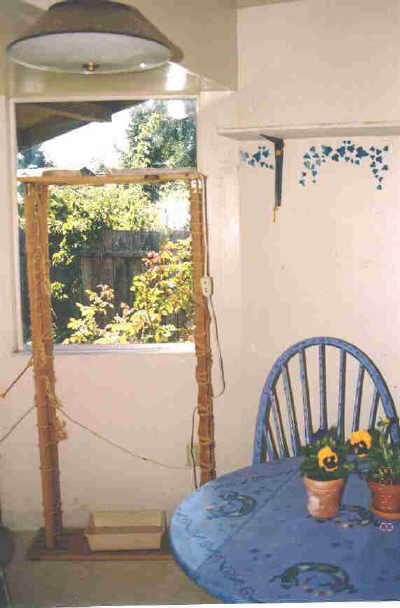
Melissa
Kaplan's
Herp Care Collection
Last updated
January 1, 2014
Setting up basking areas for free-roaming iguanas
There's more to it than just letting them run loose in your home...
©1995, 2002 Melissa Kaplan
To enable a free roaming iguana to attain the basking temperatures it needs to effect digestion, we must provide basking/sunning (with real sun or artificial sun in the form of proper UVB lighting) areas outside of the enclosure for the iguana to use when they are not enclosed. This can be accomplished by setting up a shelf or table somewhere they like or will like to be - such as where they can look out of a window - and outfit it with a people heating pad, basking light and Vitalite-type light (see below for full description of a free setup). The ig will spend 90% of its time there once it is done getting through the initial explore-and-topple-everything-and-hide-from-large-bipedal-carbon-unit-phase. If you are going to have an enclosure wherein you expect it to spend any time, you will need it to be primarily solid to ensure that the heat stays in - otherwise the equipment will work very hard and ineffectively trying to heat up the entire apartment, room or house.
In my house, the iguana areas are:
The Iguana Room
This is what
normal people would use as a breakfast room. I've hung a clear plastic
shower curtain across the opening between the kitchen and breakfast room
to retain heat in there. There are several cages (wood-and-hardware cloth
- empty; all wood open fronted for tortoises on top of which is another
wood enclosure housing a bearded), a bunch of plastic crates lining one
wall under the windows, a climber/platform I made and a long shelf running
along two of the walls about 6' above the floor. They can climb the climber,
crates and empty (4' hi) cage to access the tops of those units as well
as get up to the shelves and the top of the stacked wooden tanks. I have
heating pads, one on top of the wooden tank, one on the climber, one on
the crates, one on the empty cage and one on the shelf. I have a basking
light if needed aimed at the top of the crate. Also have a free-standing
space heater (radiant oil - looks like an old-fashioned radiator on wheels).
The temp gradient in that room is horizontal along the flat surfaces as
well as vertical, from the floor (where the is also a pad at the base
of the climber/platform) on up to the shelves 6 ft up. I can open the
windows in there most of the year for direct sun coming in most of the
day - I do not use Vita-Lite in there.
The Den
There are two adjacent tables
outfitted with heating pads sandwiched between towels. The tables are
in front of my sliding door to the outside which I can also leave open
most of the year. Also no Vitalite.
Master Bedroom
My bedroom has a two-heating
pad, basking light and Vitalite station. I can also open the door in there
for diffused sun. My room gets extremely cold during the winter so I have
a space heater in there too when needed.
Snake Room
My snake room currently
has a heating pad in it for anyone who needs some alone time from the
rest of the gang. During the winter I use a space heater in there as well
if needed.
I actually do not run my central heating much at all - only for me in the mornings for an hour or so to take the damp chill off during the rainy cold season. I also use a space heater in the den if I need it - that's where I spend most of my time.
If you are concerned about the impact of your new friends on you power bill, call your power company and ask if they can do a rate analysis to see if there is a better rate structure you might be able to use. Right now you are paying the same amount per kilowatt hour during the summer or winter (you may be paying more during peak hours, but seasonally there is probably no change). There may be a structure wherein you pay more during the summer (when you will be using it less) and less during the winter (when you will be using more) that you can change to - I did, and it cut my annual bill by about $500. A friend of mine finally got it done and by switching she will be saving about $200 a year over what she used to pay.
To set
up a basking/perching area for free roaming igs
Install a shelf
about 6 ft above the ground; you can convert a bookcase or other shelf
to this purpose. Igs prefer being able to look out a window, so situate
accordingly.
Screw the housing for the Vitalite into the wall or ceiling above it so that the light will be no farther than 18" (preferably no more than 12-15") from the ig. Also mount a light fixture to the wall - you can get them already wired by buying a Gro-light kit and using that (discard the bulb, however, unless you want to use it for daytime heating - it does NOT produce the wavelengths necessary for the creation of vitamin D and calcium metabolism). Basically you want to make this fixture as solid as possible so that the iguana doesn't knock it over - Murphy's law will prevail and instead of bulb breaking if it falls, it will land bulb down and start a fire! ;)
Put a people heating pad on the shelf. This means that you need at least three available electrical outlets; it is worth having an electrician come in and install a double-gang outlet dedicated for this purpose. Remember that you want to be able to plug the fluorescent fixture into a timer so leave yourself access to the outlet for seasonal changes.
For access, igs can climb up and down vertical surfaces so you do not need to come out into the room. You can create a climber by crisscrossing 1/4-1/2" sisal rope around 1x1s, using an electric stapler to secure. Or you can cover a 12" wide board with coarse burlap or sisal rope (some artificial carpets are too slick for this), or scrap carpet (human kind). The 1x1s or board can be affixed to the underside of the shelf using L-brackets.
You can cover the shelf with linoleum for easier cleaning and disinfecting. The pad can be covered with a terry towel, also easy to clean.
Make your iguana come down for pooping and eating - one of the big reasons for free-roaming is for the ig to get plenty of exercise, so don't deprive him or her of it by putting their food bowl up where they are already spending most of their time!
|
Above: Bay window with N/E/S exposure. Basking table constructed of PVC (frame and legs, mounted on sections of 2x4s) and modular shelving. A second shelf leans against table for climbing. The iguana pictured is a 2.5 year old Cyclura hybrid, shortly after I got him in 1999. Because he is now 19" SVL (he was 6.5" in this photo), I have laced a terry cloth towel through the rungs of the ladder to make it easier to climb. However, he usually just leaps off the wood/rope platform (right) onto the PVC unit, and from there to the floor, as he makes his way through his morning routine. Click on photos to see larger images.
|
Above: The south wall of the same room. Above the stenciled garland on the wall behind the table and chairs is one end of the L-shaped wooden shelves I mounted on the walls. Added after this photo was taken: several layers of a holey material (made for beach/pool coverups) were stapled with heavy-duty electric staples to the ends of the shelf. The iguanas use the floor-to-shelve "ladders" to climb up and down. A towel folded into a pillow sits at the far end of the shelf (not pictured) at the favorite nighttime sleeping spot. |

